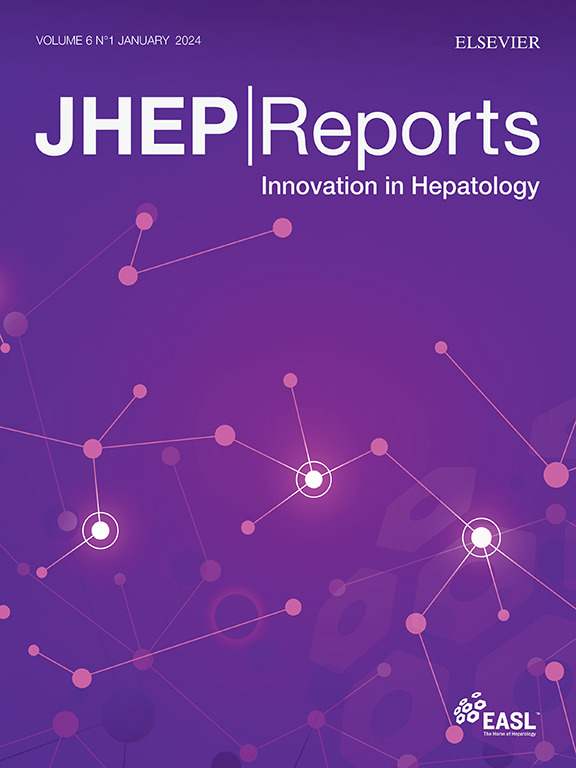Liver fibrosis progression analyzed with AI predicts renal decline
IF 9.5
1区 医学
Q1 GASTROENTEROLOGY & HEPATOLOGY
引用次数: 0
Abstract
Background & Aims
The relationship between biopsy-proven liver fibrosis progression and renal function decline in patients with metabolic dysfunction-associated steatotic liver disease (MASLD) has not been fully elucidated. We used an automated quantitative liver fibrosis assessment (qFibrosis) technique to investigate the temporal changes in regional liver fibrosis.
Methods
This retrospective longitudinal study included 68 MASLD patients and their paired formalin-fixed sections of liver biopsies. One hundred eighty-four fibrosis parameters were quantified in five different hepatic regions, including portal tract, peri-portal, zone 2, peri-central and central vein regions, and qFibrosis continuous values were calculated for all samples based on 10 fibrosis parameters using qFibrosis assessment. Liver fibrosis progression (QLF+, n = 18) and regression (QLF-, n = 23) was defined as at least a 20% relative change in qFibrosis over a 23-month follow-up. Renal function decline was assessed by estimated glomerular filtration rate (eGFR) changes.
Results
The eGFR decline was greater in the QLF+ group (106.53 ± 13.71 ml/min/1.73 m2 vs. 105.28 ± 12.46 ml/min/1.73 m2) than in the QLF- group (110.87 ± 14.58 ml/min/1.73 m2 vs. 114.18 ± 14.81 ml/min/1.73 m2). In addition, liver fibrosis changes in the central vein and pericentral regions were more strongly associated with eGFR decline than in periportal, zone 2 and portal tract regions. We combined these parameters to construct a prediction model, which better differentiated eGFR decline (a cut-off value of qFibrosis combined index = 0.52, p <0.001).
Conclusions
A decline in renal function is significantly related to liver fibrosis progression in MASLD. Regional qFibrosis assessment may efficiently predict eGFR decline, thus highlighting the importance of assessing renal function in patients with MASLD with worsening liver fibrosis.
Impact and implications
The study shows that liver fibrosis progression assessed by qFibrosis may be associated with renal function decline, which provides a new perspective for understanding complex pathological processes. A combination of artificial intelligence and digital pathology may earlier and more precisely quantify the progression of regional liver fibrosis, thus better identifying changes in renal function. This opens the possibility of early interventions, which are essential to improve patients’ outcomes.

人工智能分析肝纤维化进展预测肾功能下降
背景,目的:活检证实的代谢功能障碍相关脂肪变性肝病(MASLD)患者肝纤维化进展与肾功能下降之间的关系尚未完全阐明。我们使用自动定量肝纤维化评估(qFibrosis)技术来研究区域肝纤维化的时间变化。方法回顾性纵向研究纳入68例MASLD患者及其配对的福尔马林肝活检切片。在五个不同的肝脏区域,包括门静脉、门静脉周围、2区、中心静脉周围和中心静脉区域,量化了184个纤维化参数,并根据10个纤维化参数使用qFibrosis评估计算了所有样本的q纤维化连续值。肝纤维化进展(QLF+, n = 18)和消退(QLF-, n = 23)被定义为在23个月的随访中q纤维化相对变化至少20%。通过估计肾小球滤过率(eGFR)的变化来评估肾功能下降。结果QLF+组eGFR下降幅度(106.53±13.71 ml/min/1.73 m2比105.28±12.46 ml/min/1.73 m2)大于QLF-组(110.87±14.58 ml/min/1.73 m2比114.18±14.81 ml/min/1.73 m2)。此外,中心静脉和中心周围区域的肝纤维化变化与eGFR下降的相关性比门静脉周围、门静脉2区和门静脉束区域更强。我们结合这些参数构建预测模型,更好地区分eGFR下降(qFibrosis联合指数的临界值= 0.52,p <0.001)。结论MASLD患者肾功能下降与肝纤维化进展密切相关。区域性q纤维化评估可以有效预测eGFR下降,从而强调了在肝纤维化恶化的MASLD患者中评估肾功能的重要性。影响和意义本研究表明,qFibrosis评估的肝纤维化进展可能与肾功能下降有关,这为理解复杂的病理过程提供了新的视角。人工智能和数字病理学的结合可以更早、更精确地量化局部肝纤维化的进展,从而更好地识别肾功能的变化。这开启了早期干预的可能性,这对改善患者的预后至关重要。
本文章由计算机程序翻译,如有差异,请以英文原文为准。
求助全文
约1分钟内获得全文
求助全文
来源期刊

JHEP Reports
GASTROENTEROLOGY & HEPATOLOGY-
CiteScore
12.40
自引率
2.40%
发文量
161
审稿时长
36 days
期刊介绍:
JHEP Reports is an open access journal that is affiliated with the European Association for the Study of the Liver (EASL). It serves as a companion journal to the highly respected Journal of Hepatology.
The primary objective of JHEP Reports is to publish original papers and reviews that contribute to the advancement of knowledge in the field of liver diseases. The journal covers a wide range of topics, including basic, translational, and clinical research. It also focuses on global issues in hepatology, with particular emphasis on areas such as clinical trials, novel diagnostics, precision medicine and therapeutics, cancer research, cellular and molecular studies, artificial intelligence, microbiome research, epidemiology, and cutting-edge technologies.
In summary, JHEP Reports is dedicated to promoting scientific discoveries and innovations in liver diseases through the publication of high-quality research papers and reviews covering various aspects of hepatology.
 求助内容:
求助内容: 应助结果提醒方式:
应助结果提醒方式:


